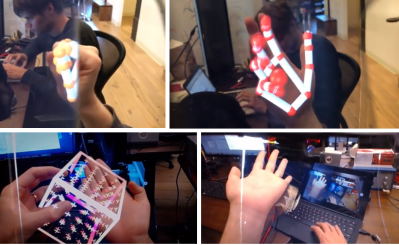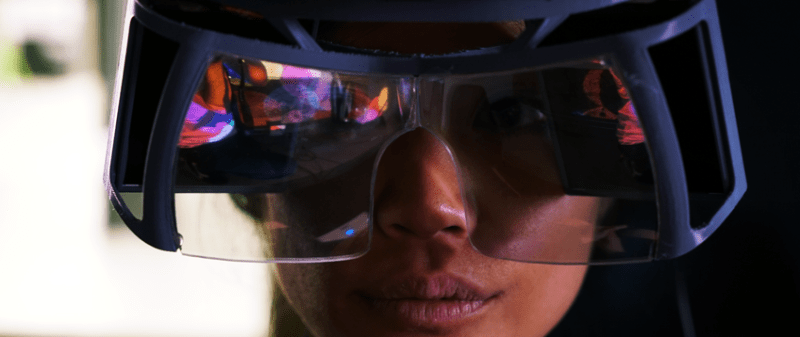Leap Motion just dropped what may be the biggest tease in Augmented and Virtual Reality since Google Cardboard. The North Star is an augmented reality head-mounted display that boasts some impressive specs:
- Dual 1600×1440 LCDs
- 120Hz refresh rate
- 100 degree FOV
- Cost under $100 (in volume)
- Open Source Hardware
- Built-in Leap Motion camera for precise hand tracking
Yes, you read that last line correctly. The North Star will be open source hardware. Leap Motion is planning to drop all the hardware information next week.
 Now that we’ve got you excited, let’s mention what the North Star is not — it’s not a consumer device. Leap Motion’s idea here was to create a platform for developing Augmented Reality experiences — the user interface and interaction aspects. To that end, they built the best head-mounted display they could on a budget. The company started with standard 5.5″ cell phone displays, which made for an incredibly high resolution but low framerate (50 Hz) device. It was also large and completely unpractical.
Now that we’ve got you excited, let’s mention what the North Star is not — it’s not a consumer device. Leap Motion’s idea here was to create a platform for developing Augmented Reality experiences — the user interface and interaction aspects. To that end, they built the best head-mounted display they could on a budget. The company started with standard 5.5″ cell phone displays, which made for an incredibly high resolution but low framerate (50 Hz) device. It was also large and completely unpractical.
The current iteration of the North Star uses much smaller displays, which results in a higher frame rate and a better overall experience. The secret sauce seems to be Leap’s use of ellipsoidal mirrors to achieve a large FOV while maintaining focus.
We’re excited, but also a bit wary of the $100 price point — Leap Motion is quick to note that the price is “in volume”. They also mention using diamond tipped tooling in a vibration isolated lathe to grind the mirrors down. If Leap hasn’t invested in some injection molding, those parts are going to make the whole thing expensive. Keep your eyes on the blog here for more information as soon as we have it!
















“They also mention using diamond tipped tooling in a vibration isolated lathe to grind the mirrors down.”
If you want to have some descent optical quality you end up doing something like this. We do this large scale with lenses for glasses so it might ain’t that expensive after all.
Leap Motion announces a lot of interesting things but as always, I’ll believe it when I it ships.
wrong leap, leap motion are the guys with USB 3.0 webcam + driver with quite brilliant hand gesture recognition, already on the market, cheap too
i also thought leap motion was related to magic leap, but i’m going to pedantically point out that leap motion’s initial offering was also delayed substantially from initial promises. it’ll be done when it’s done and until then it .. won’t be done.
They are also the guys who promised an open mobile API for the sensor, then backtracked and sold it to large corporations that have done nothing with it.
Plus with statements like “costs under $100 in volume” you have people laugh at such silly way-out-there statements and move on immediately.
Costs, not price
I think the suggestion is that with open source those become close to the same.
Note to everyone: this is Leap Motion, not Magic Leap. They’re totally separate.
On April 9 they shared their intention to publish the OSH build within the following week. Weeks later nothing but vapour. So while yes, they are separate, they share the same character of publishing vapourware.
Also keep in mind that there seems to be *no tracking* (apart from hands – which is fine but not the most important nor the hardest problem). AR headset that is not tracked in space is almost useless because it won’t be able to position the images in space around you (you will “carry” the images with you instead of them sticking to e.g. your desk or floor). So you will need to add your own – count at least $300 extra for a LightHouse and one HTC Tracker puck.
AR headsets track the space itself through cameras (usually), it won’t work to track the headset’s position because then you first need a detailed 3D map of everything in the room you are in to do the projection.
As shown by all the more well known AR occurrences out there like the Pokemon game and the Nintendo AR handheld stuff that first used AR tags you put on things and then developed into using real objects to calculate the 3D space and no longer needing the AR tags thanks to clever math and more powerful processors.
“count at least $300 extra for a LightHouse and one HTC Tracker puck.” How about a webcam and a few fiducial markers? I don’t think it needs to be the best thing ever, just pretty good. There are also some HMDs that just map the environment and seem to do okay, like Hololens or Oculus’s Santa Cruz prototype.
The Lighthouse tracking system is designed to be much more accurate and provide a much bigger tracking space than this kind of tech really needs.
On the contrary, we need the tracking area to be very large. Hololens stores tracking data as it first encounters it, and there are some very cool uses for this. My dream is to have my computer accessible from anywhere by throwing up a window, similar to the hololens demo. Imagine having a movie running in one room, while you have a chat window popped up near where you are sitting, and a floating news window with HaD opened up in the bathroom,all just floating in midair.
My cheap take on optical grade precision plastic lens is using a Form2 + surface tension based ‘redip’ polishing. Works quite nice with fresnel and simplex lenses. I bet compromise will be very acceptable considering how accessible nowadays that printer is.
Given how close the screens sit to your face, they really don’t look like they’re going to be glasses friendly at all!
Maybe not if you have huge glasses, normal sized should fit. Look at the camera “glasses” contraption and compare with a normal pair.
“Sliding the reflectors slightly out from your face gave room for a wearable camera,”
Okay, so it is possible but one wonders how detrimental sliding the reflectors out is, given in all the other shots of wearers, they’re touching their cheeks.
The sight of the large glasses reminded me of “Dark Helmet” of Spaceballs
This can double as shop protection.
This is exciting. Looking forward to the OSH file release — devil is (as always) in the details. 100 degree FOV!
This could become something exciting. Seems like a smart way to design a normal VR headset too – but what do I know?
Exciting in that it resembles part of Judge Dredd’s helmet.
That’s a plus. ;)
If the display is in that price range in quantity is there a possibility we can coordinate a Mass Drop style purchase through Hackaday?
I often wonder how this would work for visually impaired people, I myself have lost one eye, so I have issues with 3-d movies, I still use the Glasses it causes less pain and distortion. Virtual headsets are worse than useless, but this seems to use more HUD style…
same company that hyped its leap motion controller as having massive and expandable capabilities. Then they released t hobbled with a walled garden software portal that limited its functionality to a handful of developers that wanted to release anything. Ended up anything that was made available was developed to the point you could go ‘neat’, but no further.
At the same time the way the software was released was up to the developer. So often after buying the hardware you had a borderline useless aluminum widget. An attempt to make it useful meant looking at software and guessing hat might make it useful, which would most often be paid (thats fine) but have no preview capability (not fine), or preview capability that had no bearing on what the final product would actually do (also not fine).
Of course theres the open source driver for the leap motion controller. ..and last time I checked (about 6 mothes ago) it was a ghost town. Easier and more supported to do motion control with a hacked konnect.
You can hardly even notice the head gear… O.o
what about heat formed acrylic sheets for the reflectors ?